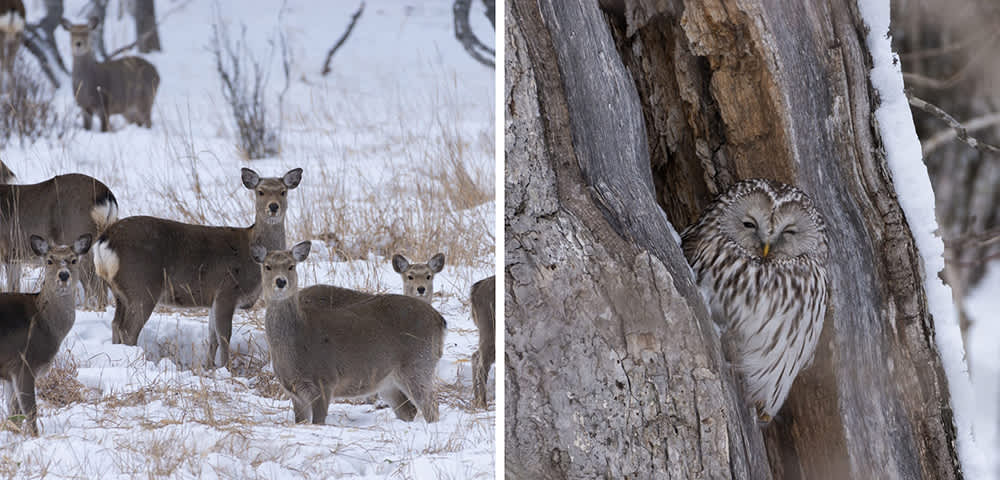
Stretching from the subarctic peaks of Hokkaido to the subtropical shores of Okinawa, the Japanese archipelago belies a surprising array of wildlife, including many rare and endemic species that cannot be seen anywhere else on earth. It may surprise some to learn that beyond the well-worn streets of Tokyo and Kyoto lies lush forests, dense jungles, and vibrant underwater worlds teeming with life. For those looking for Japan’s wilder side, here are just a few destinations to explore for close encounters of the animal kind.
Hokkaido

Japan’s wild northern frontier, Hokkaido is home to truly precious ecology from the majestic national parks and rich wetlands to the UNESCO World Natural Heritage Shiretoko Peninsula. One of Japan’s most pristine and protected national parks, the Shiretoko Peninsula is an important habitat for the native Ussuri Brown bear as well as the Blakiston’s fish owl, both of which are seen as protective deities to Hokkaido’s indigenous Ainu people. In addition to the Stellar’s sea eagle that can be seen in January and February, large pods of killer whales migrate through this area between late April and July. Wildlife cruise tours are available that allow travelers to observe brown bears, whales, birds of prey, and more from a safe distance while taking in the beautiful coastal views
The Kushiro wetlands are also an excellent place for bird watching, especially in the winter when the iconic red-crowned cranes perform their mating dances. Also sacred to the Ainu people is Akan-Mashu National Park, where Ezo red foxes and wild deer can be seen and Ainu guided forest walks are available to learn more about Hokkaido’s wildlife as it relates to indigenous culture.
Toyooka

Another of Japan’s revered bird species is the oriental white stork, believed to be a good luck charm for love and fertility. Many conservation efforts are underway in Hyogo prefecture and several areas in Toyooka city are designated as wildlife reserves. Hyogo Park of the Oriental White Stork is a wildlife sanctuary and a great place to see Japan's amazing wildlife in natural surroundings. The sanctuary is home to over 150 oriental white storks, which are a designated a threatened species in Japan. The sanctuary is also a great place to see other endemic and migratory birds, such as the red-billed turtle dove and the white-winged woodpecker. Together with the Hachigoro Toshima Wetlands in Kinosaki Onsen, these important and publicly accessible nature preserves are working to educate the public and preserve this beautiful species for future generations.
Yakushima

The mystical island of Yakushima in Kyushu’s southernmost prefecture of Kagoshima has been the inspiration for beloved films and ranks high on the travel bucket lists of adventure and wildlife enthusiasts alike. The island’s peculiar climate ranges from subtropical to cool temperate and the local joke is that it rains on the island 32 days out of the month, creating a lush rainforest that is home to several rare and endemic species of flora and fauna. Aside from the famed Jomon-sugi trees, some of which are reportedly over 7,000 years old, subspecies of Japanese macaque (Yakushima-zaru) and deer (Yaku-shika) can be found on the island which is also a nesting ground for loggerhead turtles. The turtles return to the island to lay their eggs on Nagata Beach between May and July. Biodiversity tours and diving tours are available for travelers looking to expand their knowledge of the island’s diverse wildlife and get the chance to catch a glimpse of these protected species from a safe and respectful distance.
Okinawa

While most may be familiar with the main island of Okinawa, few make their way to the southernmost islands in the Okinawan chain but those that do, will find a diverse array of wildlife and outdoor activities to delight any traveler. From white sandy beaches and crystal-clear waters to lush rainforests and waterfalls, the Yaeyama Islands of Okinawa are a paradise unlike any other.
Ishigaki Island, easily accessible by domestic flight from Tokyo and Osaka, is part of the Iriomote-Ishigaki National Park and is a diver’s dream. The waters around Kabira Bay are known for having impressive visibility and for being a hot bead for reef manta rays, earning it the nickname Manta Scramble. Between June and October, untold number of manta rays migrate through this area with an 80% sight rate for divers. Nearby Iriomote Island was just recognized as a UNESCO World Natural Heritage Site and the islands dense rainforest and expansive mangroves are home many native species including the rare Iriomote cat and endangered yellow-margined box turtle. Canoeing through the mangroves and nighttime nature trekking are popular activities for travelers seeking to catch a glimpse of the island’s nocturnal and elusive feline.



















































